Categories
- Antiques & Collectibles 13
- Architecture 36
- Art 48
- Bibles 22
- Biography & Autobiography 813
- Body, Mind & Spirit 142
- Business & Economics 28
- Children's Books 15
- Children's Fiction 12
- Computers 4
- Cooking 94
- Crafts & Hobbies 4
- Drama 346
- Education 46
- Family & Relationships 57
- Fiction 11828
- Games 19
- Gardening 17
- Health & Fitness 34
- History 1377
- House & Home 1
- Humor 147
- Juvenile Fiction 1873
- Juvenile Nonfiction 202
- Language Arts & Disciplines 88
- Law 16
- Literary Collections 686
- Literary Criticism 179
- Mathematics 13
- Medical 41
- Music 40
- Nature 179
- Non-Classifiable 1768
- Performing Arts 7
- Periodicals 1453
- Philosophy 64
- Photography 2
- Poetry 896
- Political Science 203
- Psychology 42
- Reference 154
- Religion 513
- Science 126
- Self-Help 84
- Social Science 81
- Sports & Recreation 34
- Study Aids 3
- Technology & Engineering 59
- Transportation 23
- Travel 463
- True Crime 29
A New Supspecies of Slider Turtle (Pseudemys scripta) from Coahuila, Mexico
by: John M. Legler
Description:
Excerpt
In September, 1958, the author and two colleagues collected a large series of Pseudemys in small ponds and in a river in the basin of Cuatro Ciénegas, Coahuila. The specimens prove to represent a previously unrecognized subspecies of Pseudemys scripta. The subspecies is named in honor of Edward Harrison Taylor who has contributed more than any other person to our present knowledge of the herpetofauna of México.
Pseudemys scripta taylori new subspecies
(Pls. 9-12, Figures 1 & 2)
Holotype.—Univ. Kansas Mus. Nat. Hist., No. 46952, adult female, alcoholic; 16 km. S Cuatro Ciénegas, Coahuila, México; 6 September 1958; original number 1694 John M. Legler.
Paratypes.—A total of 52 specimens as follows (numbers or series of numbers marked with an asterisk are for specimens prepared as dry shell with soft parts in alcohol): KU 46932-4*, 46949-51, 46953-67, 46969 (females), 46935*, 46936-48, 46968 (males), same data as holotype, 6 to 8 September 1958; UU 3416 (male), same locality, 29 to 30 July 1959; KU 46971, 46973* (females), 46972 (male), 46970, 46974 (juveniles), 6 mi. W Cuatro Ciénegas, 3 to 6 September 1958; IU 43585, 43587-9 (females), 43586, 43590 (males), same locality, 11 July 1958; CNHM 55655 (female), same locality, 22 August 1939; KU 46976 (female), RÃo Chiquito, 10 km. S Cuatro Ciénegas, 9 September 1958; UU 3415 (female), 8.5 mi. SW Cuatro Ciénegas, 1 August 1959.
Diagnosis.—A subspecies of Pseudemys scripta most closely resembling P. s. elegans, but differing from that subspecies in having: 1) extensive black plastral pattern, all parts of which are interconnected, covering approximately half of plastron; 2) tendency toward melanism, in large adults of both sexes, especially noticeable on posterior part of plastron; 3) cutting edge of lower jaw coarsely serrate; 4) tendency for femoral edges of plastron to be reflected ventrally, especially in males; and, 5) pectoral scute longer than gular.
Table 1. Measurements (in millimeters) of the Holotype (46952) and Nine Adult, Topotypic Paratypes of Pseudemys scripta taylori New Subspecies. Height Was Measured in a Vertical Line from the Center of the Plastron.
Collection and Catalogue No.SexLength of CarapaceWidth of CarapaceLength of PlastronWidth of Plastral Forelobe (Humeropectoral)Width of Plastral Hind Lobe (Mid-femoral)HeightWidth of HeadKU 46948ââ¢â17912715771696928KU 46941ââ¢â148107129595957KU 46968ââ¢â139991165457KU 46937ââ¢â128100115544721KU 46944ââ¢â105829346433819KU 46932ââ¢â¬21415819686848737KU 46952ââ¢â¬14918687867933KU 46957ââ¢â¬18813816779806831KU 46959ââ¢â¬15611814971717029KU 46962ââ¢â¬13210111958535124Description of holotype (measurements given in Table 1).—Carapace oval in dorsal aspect, slightly narrowed behind, nearly straight across anterior margin, bluntly serrate behind; shell deep, highly arched in cross section; height of shell 53 per cent of width; surface of shell having longitudinal striations; middorsal keel weakly developed, scarcely discernible except on third central lamina; lateral margin of carapace not at all reflected, posterolateral margins flared outward; central laminae all broader than long, the first urn-shaped.
Ground color of carapace (hereinafter, colors are those of preserved specimen) dark olive; upper surface of each marginal scute having round or oval black mark, two such marks on each marginal of first pair; marks on margin of anterior half of carapace having pale orange-yellow borders, marks more posteriorly having indistinct borders or no border; upper surface of carapace having numerous, irregularly arranged black marks on a faint reticulum of pale lines; one or two large oval marks on each lateral scute arranged more or less vertically, other marks on laterals irregular in size and arrangement; central scutes having three to five longitudinally arranged, narrow black marks on each scute....




